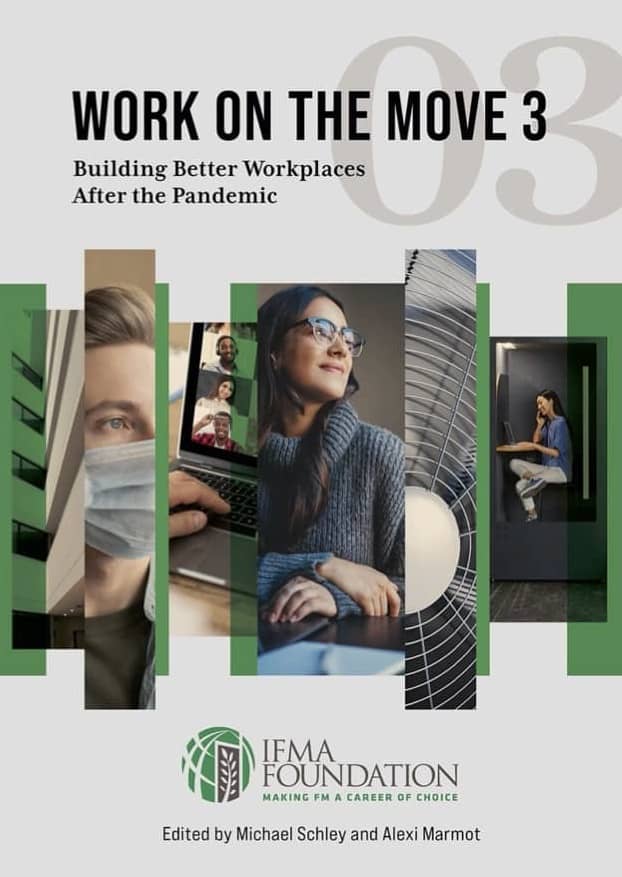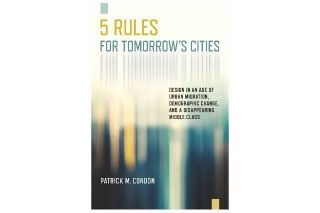
www.buildingsandcities.org/insights/reviews/building-better-workplaces.html
Work on the Move 3: Building Better Workplaces After the Pandemic
Edited By Michael Schley and Alexi Marmot. IFMA, 2021, ISBN: 9781737903222
Chiara Tagliaro (Politecnico di Milano) reviews this book which considers the nature and practices for the post-Covid workplace as a hybrid of virtual and on site activities.

If it's true that "good things come in threes", then Work on the Move 3 is no exception, coming after Work on the Move in 2011 and Work on the Move 2 in 2016. Both the previous books sponsored by the IFMA Foundation were widely appreciated for helping facility managers and other workplace professionals around the globe make sense of the progressive evolution of work. This latest volume promises to be the right complement to the preceding editions by problematizing the role played by Covid-19 in the context of work and workplaces, including implications at the corporate real estate level.
Edited by Michael Schley and Alexi Marmot, the text reflects both their professional expertise and academic profile. This book has a unique quality of being written in clear, accessible language and narrative, whilst providing solid support for its arguments based on data from white and grey literature.
The main thread develops around the idea that work is going to be hybrid, meaning that part of the activities will be performed on site and others will be virtual. The office is expected to become primarily a place for collaboration, interaction, and innovation, while employees will navigate across different workplaces at different times of the day. In this scenario, facilities management (FM) plays a fundamental role, both as an enabler of the changing role of the office and itself as an evolving organization.
The only way to successfully adapt to this new hybrid mode is the adoption of a convincing workplace strategy built on a business case, which will be the mission of 'workplace management'. A valuable contribution of the book is in the attempt to disseminate one of the few, if not the only, available definitions of workplace management (see p. 17). Another important contribution is that it explains how to actually embrace a workplace management mindset.
The narrative guides the reader to
embrace this new mindset. This is achieved by describing a path for the
creation of a workplace experience. (This
is in contrast to a traditional approach which focuses first on design issues and
then on issues such as people's well-being, sustainability, the provision of
services, tech choices, etc.) Instead, this book places the design phase at
the end. This is the correct approach when one needs to completely rethink the
whole organization of work and not only the arrangement of a handful of
workstations.
The sequence of the chapters unfolds from considerations about people's health and wellbeing at work, to planetary health and sustainability, diversity, equity and inclusion in facility management, technology and smart workplaces, innovations in real estate and workplace localization, and finally dynamic provisioning of services in the workplace. All this occurs before introducing novel approaches to designing the post-pandemic workplace.
Referring to the classic process of workplace creation and management, the journey proposed in this book starts with first principles. This is likely to be the most attractive journey for workplace visionaries and the most effective to be taken in the pandemic's aftermath, when everything needs to be reconsidered from their roots. Both workplace practitioners and researchers are offered a meaningful collection of stimulating ideas followed by case studies for a future hybrid work mode and the evolution of organizations, workspaces and services that gravitate around that. Yet, the book does even more.
The sensitivity and qualification of the authors is evident in a rare attention to terminology, that is especially appreciated in a time when linguistic confusion is diffused due to an overwhelming sprout of buzzwords. The book provides original concepts that, more than simple hapax legomenon, deserve to become neologisms. These include: placefulness and workplaces worth the journey, which are both effective expressions anticipating some of the key characteristics of future workplaces. The first term draws on the idea of mindfulness and peacefulness that should be integrated into future neighbourhoods for a more balanced life and workstyle. The second term reminds us that workplaces will increasingly be elective places, thus they need to offer exceptional quality to justify the time and resources taken to reach them. Both these principles go under the umbrella concept of wellworking, which would encompass health, hygiene, well-being and flourishing in the digital and physical workplace.
How could all this possibly come true? By considering 'design' as a verb rather than a noun, in order for it to be a problem-solving process more than a simple end product. Workplace management itself and the concept of experience find a definition in the volume. It helps consider these terms as evolving practices instead of well-defined acts or confined events. As the workplace evolves, so does the vocabulary that describes it.
If spoilers don't disturb the reader, one could jump first to the case studies that are presented in the last 100 pages. Eight companies (from Australia, Austria, Canada, US, and New Zealand) from different sectors (public administration, health care financial services, technology, etc.) present their most recent workplace changes. All the cases are recounted based on a description of the organization and the country where the case is located; an overview of the post-Covid landscape; the business drivers shaping the approach to the workplace; the workplace strategy and solution complemented by people strategies (change management, policies and training for adaptation), technology strategies, and design/environment strategies; desired impact to business and measurement of success; and the key learning and advice to others.
If readers go back to the beginning of the text, they would realize that among the common drivers of a workplace change are the attraction and retention of talent, reducing costs, accounting for "environmental, social and governance" (ESG), and the desire to align culture and create an equitable work environment. Companies are looking to enhance the organizational culture through the workplace, which encompasses increasing flexibility, boosting the sense of belonging and engagement of the workforce, and augmenting their reputation as a remarkable place for workers and civil society.
The idea of hybrid work is fully embraced by all the case studies. Strategies entail the creation of neighbourhoods, partnerships with third spaces, cafés within the office and a range of other multimodal workspaces. Finally, the implementation of these strategies is obtained thanks to the involvement of employees in participatory processes through pilot projects, surveys, visioning sessions, and strong change management plans including proper community managers.
Last but not least, the name of the different initiatives or workplace models taking place in each company case study often evokes the idea of something on the move: from Workplace of the Future to Dynamic Work, to Playground and Propeller Framework. While flexible work policies will be the norm, within the general framework of a hybrid workplace the future approach is called either 'organic', or 'vibrant'. All terms that recall something alive, the subtle changes that lively entities undergo continuously toward something else.
Not by chance, many of the 19 authors have been involved in the inception and expansion of the Workplace Evolutionaries (WE) initiative. This panel of experienced workplace stakeholders assembled invaluable insights that stem from acute observation of people and organizations at work, before and during Covid-19 as well as beyond. The book's title already anticipates that each chapter addresses lessons from the pandemic. These are especially meaningful because they are integrated into an unfolding pathway that workplaces are already on.
The authors are to be applauded for creating a highly accessible, useful and profound book about the principles and practices surrounding the hybrid workplace. This is a much-needed book and it deserves to be widely read and discussed by all the many stakeholders involved in making workplaces.
Latest Peer-Reviewed Journal Content
A framework for 1.5°C-aligned GHG budgets in architecture
G Betti, I Spaar, D Bachmann, A Jerosch-Herold, E Kühner, R Yang, K Avhad & S Sinning
Net zero retrofit of the building stock [editorial]
D Godoy-Shimizu & P Steadman
Co-learning in living labs: nurturing civic agency and resilience
A Belfield
The importance of multi-roles and code-switching in living labs
H Noller & A Tarik
Researchers’ shifting roles in living labs for knowledge co-production
C-C Dobre & G Faldi
Increasing civic resilience in urban living labs: city authorities’ roles
E Alatalo, M Laine & M Kyrönviita
Co-curation as civic practice in community engagement
Z Li, M Sunikka-Blank, R Purohit & F Samuel
Preserving buildings: emission reductions from circular economy strategies in Austria
N Alaux, V Kulmer, J Vogel & A Passer
Urban living labs: relationality between institutions and local circularity
P Palo, M Adelfio, J Lundin & E Brandão
Living labs: epistemic modelling, temporariness and land value
J Clossick, T Khonsari & U Steven
Co-creating interventions to prevent mosquito-borne disease transmission in hospitals
O Sloan Wood, E Lupenza, D M Agnello, J B Knudsen, M Msellem, K L Schiøler & F Saleh
Circularity at the neighbourhood scale: co-creative living lab lessons
J Honsa, A Versele, T Van de Kerckhove & C Piccardo
Positive energy districts and energy communities: how living labs create value
E Malakhatka, O Shafqat, A Sandoff & L Thuvander
Built environment governance and professionalism: the end of laissez-faire (again)
S Foxell
Co-creating justice in housing energy transitions through energy living labs
D Ricci, C Leiwakabessy, S van Wieringen, P de Koning & T Konstantinou
HVAC characterisation of existing Canadian buildings for decarbonisation retrofit identification
J Adebisi & J J McArthur
Simulation and the building performance gap [editorial]
M Donn
Developing criteria for effective building-sector commitments in nationally determined contributions
P Graham, K McFarlane & M Taheri
Reimagining circularity: actions for optimising the use of existing buildings
R Lundgren, R Kyrö, S Toivonen & L Tähtinen
Effective interdisciplinary stakeholder engagement in net zero building design
S Vakeva-Baird, F Tahmasebi, JJ Williams & D Mumovic
Metrics for building component disassembly potential: a practical framework
H Järvelä, A Lehto, T Pirilä & M Kuittinen
The unfitness of dwellings: why spatial and conceptual boundaries matter
E Nisonen, D Milián Bernal & S Pelsmakers
Environmental variables and air quality: implications for planning and public health
H Itzhak-Ben-Shalom, T Saroglou, V Multanen, A Vanunu, A Karnieli, D Katoshevski, N Davidovitch & I A Meir
Exploring diverse drivers behind hybrid heating solutions
S Kilpeläinen, S Pelsmakers, R Castaño-Rosa & M-S Miettinen
Urban rooms and the expanded ecology of urban living labs
E Akbil & C Butterworth
Living with extreme heat: perceptions and experiences
L King & C Demski
A systemic decision-making model for energy retrofits
C Schünemann, M Dshemuchadse & S Scherbaum
Modelling site-specific outdoor temperature for buildings in urban environments
K Cebrat, J Narożny, M Baborska-Narożny & M Smektała
Understanding shading through home-use experience, measurement and modelling
M Baborska-Narożny, K Bandurski, & M Grudzińska
Building performance simulation for sensemaking in architectural pedagogy
M Bohm
Beyond the building: governance challenges in social housing retrofit
H Charles
Heat stress in social housing districts: tree cover–built form interaction
C Lopez-Ordoñez, E Garcia-Nevado, H Coch & M Morganti
An observational analysis of shade-related pedestrian activity
M Levenson, D Pearlmutter & O Aleksandrowicz
Learning to sail a building: a people-first approach to retrofit
B Bordass, R Pender, K Steele & A Graham
Market transformations: gas conversion as a blueprint for net zero retrofit
A Gillich
Resistance against zero-emission neighbourhood infrastructuring: key lessons from Norway
T Berker & R Woods
Megatrends and weak signals shaping future real estate
S Toivonen
A strategic niche management framework to scale deep energy retrofits
T H King & M Jemtrud
Generative AI: reconfiguring supervision and doctoral research
P Boyd & D Harding
Exploring interactions between shading and view using visual difference prediction
S Wasilewski & M Andersen
How urban green infrastructure contributes to carbon neutrality [briefing note]
R Hautamäki, L Kulmala, M Ariluoma & L Järvi
Implementing and operating net zero buildings in South Africa
R Terblanche, C May & J Steward
Quantifying inter-dwelling air exchanges during fan pressurisation tests
D Glew, F Thomas, D Miles-Shenton & J Parker
Western Asian and Northern African residential building stocks: archetype analysis
S Akin, A Eghbali, C Nwagwu & E Hertwich
Join Our Community

The most important part of any journal is our people – readers, authors, reviewers, editorial board members and editors. You are cordially invited to join our community by joining our mailing list. We send out occasional emails about the journal – calls for papers, special issues, events and more.
We will not share your email with third parties. Read more



Latest Commentaries
COP30 Report
Matti Kuittinen (Aalto University) reflects on his experience of attending the 2025 UN Conference of the Parties in Belém, Brazil. The roadmaps and commitments failed to deliver the objectives of the 2025 Paris Agreement. However, 2 countries - Japan and Senegal - announced they are creating roadmaps to decarbonise their buildings. An international group of government ministers put housing on the agenda - specifying the need for reduced carbon and energy use along with affordability, quality and climate resilience.
Building-Related Research: New Context, New Challenges
Raymond J. Cole (University of British Columbia) reflects on the key challenges raised in the 34 commissioned essays for Buildings & Cities 5th anniversary. Not only are key research issues identified, but the consequences of changing contexts for conducting research and tailoring its influence on society are highlighted as key areas of action.